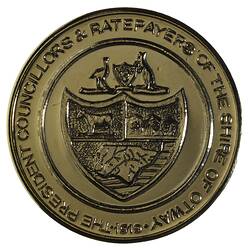The Shire of Colac was located in Victoria's western district. The town of Colac, 148 km west of Melbourne, vies with Buninyong and Kilmore for the title of oldest inland town in Victoria. Colac, known as 'the Gateway to the Otway Ranges', is situated on the southern shore of Lake Colac, one of more than 50 lakes in the district.
Kolijon (or Coladjin) Aborigines lived in the Colac Shire region prior to European settlement. The name 'Colac' is thought either to derive from this tribal name or from the Kolijon word 'kolak', meaning sand or fresh water of lake.
The first European in the area was pastoralist Hugh Murray, who arrived in Geelong in 1837 and headed west with other pastoralists, sheep and horses. He settled at Barongarook Creek on the southern shore of Lake Colac and built his first homestead in what is now Chapel Street in 1840. The same year that Murray arrived explorers Joseph Gellibrand and George Hesse, of the Port Phillip Association, went missing in the area. Their bodies were never located and they were presumed killed by Aborigines.
1837 was a better year for William Robertson. He purchased the rights to 5000 acres at Colac and, six years later, bought further land. Other settlers included Alexander Dennis and John Calvert who established the 'Warncoort' and 'Irrewarra' runs respectively in 1840, built substantial pastoral enterprises and erected impressive homesteads. Dennis later successfully cross-bred Merino and Lincoln sheep, creating the Polwarth breed, suited to areas of higher rainfall; Calvert established the Dreeite-Cotswold breed.
The fertile Colac area also came to support a range of agriculture and dairying activities, while timber harvesting became a significant industry in the nearby Otway Ranges. The district became noted for its onions, potatoes, cattle, pigs and poultry.
In 1839 a Methodist mission was established at Buntingdale. The Coladjin people were amongst those subject to the mission. It was visited in 1841 by Protector of Aborigines, George Robinson, who arranged a fireworks display.
The settlement at Colac developed around a coaching inn built in 1844 at the southern end of the lake. The site was surveyed the same year and sales of small plots began the following year. A general store and blacksmithy were soon established. Colac developed as a market and transport centre.
In 1847 the well-known religious identity Reverend Dunmore Lang took up land to the west of Colac. He subdivided it and sold the allotments in England. The following year the first post office opened, a Presbyterian chapel was erected, a court of petty sessions was founded and Buntingdale mission closed. Public infrastructure continued to develop, with a court and day school, as well as a second hotel, public pound, wheelwright and carpenter's shop and butcher's soon opening. A national school was established at East Colac in 1850, along with a second general store, the Colac Hotel and a brickmaking works. By 1851 Colac boasted a population of 672.
The first flour mill was constructed in 1852 and a bridge was built over Barongarook Creek in 1855. The first Catholic Church was erected in 1856 and a Methodist Church in 1857-58. A steam flour mill was built in 1857, the year the population crept up to 791. That same year, Thomas Austin of Winchelsea deliberately released rabbits on his estate. They soon reached plague proportions, prompting the construction of the stone walls which distinguish the area. In an eminently practical response, a rabbit canning factory was built in 1871. Millions of rabbits were canned here and at Camperdown for export to Great Britain.
In 1859 the first Colac Agricultural Show was held, the same year the Colac Roads District was created. The Shire of Colac was proclaimed on 10 May 1864 and the first bank opened in town.
Colac's first newspaper, the Observer, was published in 1866. The Duke of Edinburgh visited the Shire of Colac the following year. 1870 saw the first organized tourist boats on Lake Colac.
The railway arrived in 1877; the first hospital was built two years later.
Some of the old pastoral runs were subdivided late in the nineteenth century for closer settlement. This process was intensified by further subdivisions after World War I for soldier settlement schemes.
The first community hospital in Victoria was opened at Colac in 1934. The Colac settlement became a borough on 19 January 1938, a town on 21 January 1948 and a city on 26 January 1960.
On 23 September 1994 the City and Shire of Colac, Shire of Otway and part of the Shire of Heytesbury were united by order of the Governor in Council to form the Colac-Otway Shire Council.
References:
Blake, L. (1977). Place Names of Victoria; Fairfax Walkabout Australian Travel Guide website http://www.walkabout.com.au/locations/VICColac.shtml, accessed 10/12/2003.
People's Voice: Australian Community History On-line website http://www.peoplesvoice.gov.au/stories/vic/colac/colac_c.htm, accessed 10/12/2003.
Municipal Association of Victoria website http://www.mav.asn.au/, accessed 10/12/2003.
More Information
-
Keywords
-
Localities
-
Authors
-
Article types











